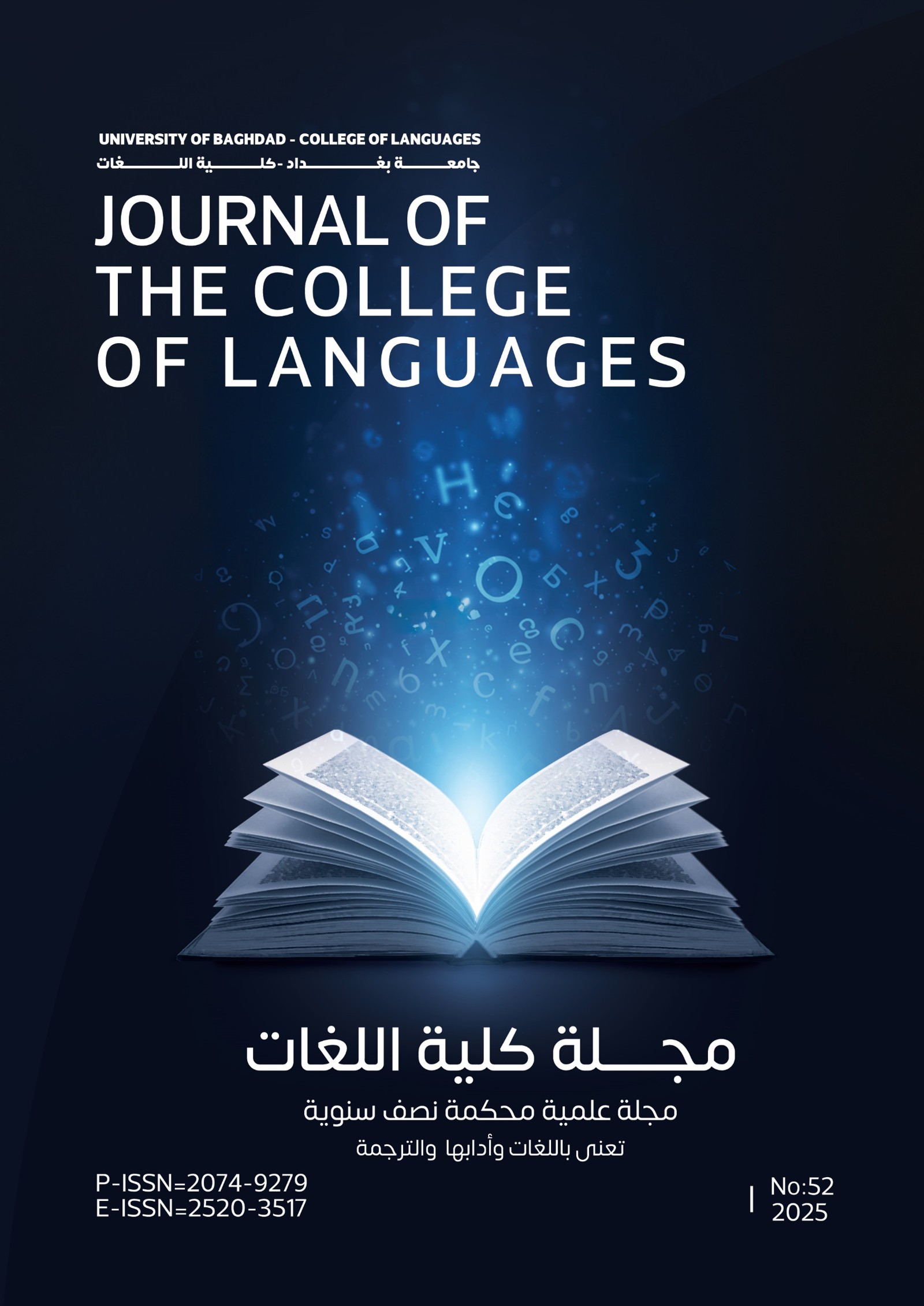Beyond Skin-Deep: The Relationship between Beauty Ideals and Identity Crisis in Scott Westerfeld's Uglies
DOI:
https://doi.org/10.36586/jcl.2.2023.0.48.0070Keywords:
Beauty, brainwashing, cosmetic surgery, identity, loveAbstract
Uglies (2005) is the first in Scott Westerfeld's Uglies series of novels. It is a science fiction literary work with a futuristic scenario that depicts a dystopian world in which people are preoccupied with unnatural standards of beauty. This novel essentially examines the themes of beauty, identity and brainwashing. It also generates a debate regarding the damaging practices of cosmetic surgery. Adopting Erik Erikson's identity development theory and Henri Tajfel and John Turner's social identity theory as theoretical frameworks, this paper presents an analysis of how the pursuit of beauty ideals contributes to the formation of an externally appealing but inwardly conflicted self-image.
Received on 22/2/2023
Accepted on 15/5/2023
Published on 1/6/2023
References
Abdullah, O. M., & Fayadh, Z. H. (2020). Question of Identity: Mimicry and Decolonization in Jhumpa Lahiri's Selected Short Stories. Al-Adab Journal, 0(134), 13–28. https://doi.org/10.31973/aj.v0i134.827
Abrams, D. & Hogg, M. A. (1990). Social Motivation, Self-esteem and Social Identity. In D. Abrams & M. A. Hogg (Eds.), Social Identity Theory: Constructive and Critical Advances (pp. 28–47). England, United Kingdom: Harvester Wheatsheaf.
Abrams, D., Marques, J. M., Bown, N., & Henson, M. (2000). Pro-norm and Anti-norm Deviance within and between Groups. Journal of Personality and Social Psychology, 78(5), 906–912. https://doi.org/10.1037/0022-3514.78.5.906
Azeez, R. A. (2022). The Inner Wasteland in Selected Later Plays of Samuel Beckett. Journal of the College of Languages, 0(46), 1–24. https://doi.org/10.36586/jcl.2.2022.0.46.0001
Baumeister, R. F., & Vohs, K. D. (2007). Encyclopedia of Social Psychology. London, United Kingdom: SAGE Publications.
Benwell, B. (2006). Discourse and Identity. Edinburgh, United Kingdom: Edinburgh University Press.
Claeys, G. (2017). Dystopia: A Natural History. Oxford, United Kingdom: Oxford University Press.
Chandler, D., & Munday, R. (2011). A Dictionary of Media and Communication. Oxford, United Kingdom: Oxford University Press.
Erikson, E. H. (1993). Childhood and Society. New York, United States: W. W. Norton & Company.
Alhamdani, F. Y. (2011). Acquired Error in using Antibiotic for Surgery Patients in Iraqi Hospitals. Iraqi Journal of Pharmaceutical Sciences, 20(2), 102–106. https://doi.org/10.31351/vol20iss2pp102-106
Alhamdani, F. Y., & Alhamdani, F. Y. (2017). Single Dose Antibiotic Prophylaxis in Outpatient Oral Surgery Comparative Study. Iraqi Journal of Pharmaceutical Sciences, 17(2), 41–46. https://doi.org/10.31351/vol17iss2pp41-46
Haslam, A. S. (2001). Psychology in Organizations. London, United Kingdom: SAGE Publications.
Hogg, M. A. (2016). Social Identity Theory. In S. M. Jones, R. Haji, N. Ferguson, & S. McKeown (Eds.), Understanding Peace and Conflict Through Social Identity Theory: Contemporary Global Perspectives (pp. 3-17). Berlin, Germany: Springer International Publishing.
Hogg, M. A., & Wagoner, J. A. (2017). Normative Exclusion and Attraction to Extreme Groups: Resolving Identity-Uncertainty. In K. D. Williams, & S. A. Nida (Eds.), Ostracism, Social Exclusion and Rejection (pp. 207-224). England, United Kingdom: Routledge.
Hussein, H. N. (2022). The Possibility of Truth and Justice in Ariel Dorfman's Death and the Maiden. Alustath Journal for Human and Social Sciences, 61(3), 577–587. https://doi.org/10.36473/ujhss.v61i3.1774
Ismael, N. A. (2022). Candles in Babylon: Denise Levertov's Spiritual Journey. Alustath Journal for Human and Social Sciences, 61(4), 422–433. https://doi.org/10.36473/ujhss.v61i4.1954
Jabbar, A. L., & Dakheel, R. M. (2018). The Narrator's Search for Her Identity in Margaret Atwood's Surfacing. Al-Adab Journal, 1(127), 1–12. https://doi.org/10.31973/aj.v1i127.196
MacDonald, G., & Leary, M. R. (2013). Individual Differences in Trait Self-Esteem: A Theoretical Integration. In M. Leary, & J. Tangney (Eds.), Handbook of Self and Identity (pp. 354–377). New York, United States: Guilford Publications.
Mohamed, S., & Mecheser, A. E. (2012). Assessment of Patients' Knowledge Toward Total Hip Replacement Home – Care. Iraqi Journal of Pharmaceutical Sciences, 21(1), 39–45. https://doi.org/10.31351/vol21iss1pp39-45
Quattrone, G. A., & Jones, E. E. (1980). The Perception of Variability within In-groups and Out-groups: Implications for the Law of Small Numbers. Journal of Personality and Social Psychology, 38(1), 141–152. https://doi.org/10.1037/0022-3514.38.1.141
Salih, N. T., & Kadhim, D. J. (2017). Adherence to American Society of Health-System Pharmacists Surgical Antibiotic Prophylaxis Guideline in Medical City Teaching Hospitals/Baghdad. Iraqi Journal of Pharmaceutical Sciences, 25(2), 40–45. https://doi.org/10.31351/vol25iss2pp40-45
Sherif, M. (1966). In Common Predicament: Social Psychology of Intergroup Conflict and Cooperation (The International Series in the Behavioral Sciences). Massachusetts, United States: Houghton Mifflin.
Simon, B., & Brown, R. (1987). Perceived Intragroup Homogeneity in Minority-Majority Contexts. Journal of Personality and Social Psychology, 53(4), 703–711. https://doi.org/10.1037/0022-3514.53.4.703
Stangor, C., & Jost, J. T. (1997). Commentary: Individual, Group and System Levels of Analysis and Their Relevance for Stereotyping and Intergroup Relations. In R. Spears, P. J. Oakes, N. Ellemers, & S. A. Haslam (Eds.), The Social Psychology of Stereotyping and Group Life (pp. 336–358). Oxford, United Kingdom: Blackwell Publishing.
Taha, A. A. (2006). The Image of the Anti-hero in James Joyce's Ulysses. Journal of the College of Languages, 0(16), 1-17.
Tajfel, H. (1972). Social Categorization. English Manuscript of 'La Catégorisation Sociale'. In S. Moscovici (Ed.), Introduction à la Psychologie Sociale (pp. 272–302). Paris, France: Larousse.
Tajfel, H. (1974). Social Identity and Intergroup Behaviour. Social Science Information, 13(2), 65–93. https://doi.org/10.1177/053901847401300204
Tajfel, H. (1975). The Exit of Social Mobility and the Voice of Social Change: Notes on the Social Psychology of Intergroup Relations. Social Science Information, 14(2), 101–118. https://doi.org/10.1177/053901847501400204
Tajfel, H., & Turner, J. C. (1979). An Integrative Theory of Intergroup Conflict. In W. G. Austin & S. Worchel (Eds.), The Social Psychology of Intergroup Relations (pp. 33–47). California, United States: Brooks/Cole.
Turner, J. C. (1987). Rediscovering the Social Group: A Self-Categorization Theory. Oxford, United Kingdom: Blackwell Publishing.
Turner, J. C., Hogg, M. A., Oakes, P. J., Reicher, S. D., & Wetherell, M. S. (1987). Rediscovering the Social Group: A Self-categorization Theory. Oxford, United Kingdom: Blackwell Publishing.
Wasserman R. (2009). Best Friends for Never. In S. Westerfeld (Ed.), Mind-Rain: Your Favorite Authors on Scott Westerfeld's Uglies Series (pp. 19-41). Texas, United States: BenBella Books, Inc.
Westerfeld, S. (2011). Uglies. New York, United States: Simon Pulse.
Westerfeld, S. (2013). Mind-Rain: Your Favorite Authors on Scott Westerfeld's Uglies Series. New York, United States: Scholastic.
Westerfeld, S., & Phillips, C. (2008). Bogus to Bubbly: An Insider's Guide to the World of Uglies. New York, United States: Simon & Schuster Books for Young Readers.
Wolf, N. (2002). The Beauty Myth: How Images of Beauty Are Used Against Women. New York, United States: Harper Perennial.
Downloads
Published
Issue
Section
License
Copyright (c) 2023 Journal of the College of Languages (JCL)

This work is licensed under a Creative Commons Attribution 4.0 International License.








